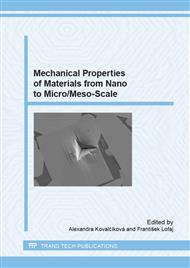p.39
p.43
p.47
p.51
p.55
p.59
p.65
p.69
p.73
Influence of Microstructure on Tribological Properties and Nanohardness of Silicon Carbide Ceramics
Abstract:
The influence of microstructural variations on the tribological properties and nanohardness of liquid phase sintered silicon carbide (LPS SiC) has been observed. In order to modify the microstructures samples were further heat treated at 1650°C and 1850°C for 5 hours to promote grain growth. The depth-sensing indentation tests of SiC materials were performed at several peak loads in the range 10-400 mN. The pin-on-flat dry sliding friction and wear experiments have been made on SiC ceramics in contact with Al2O3 ceramic ball at 10-50 N loads in an ambient environment. The nanohardness of samples with plate-like microstructure was about 34 GPa i.e. 3 GPa higher than nanohardness of SiC with fine globular microstructure. The SiC materials with coarser plate-like microstructure had similar COF (0.4-0.55) and better wear resistance (one order of magnitude at normal forces 10-20N) than SiC materials with fine globular microstructure.
Info:
Periodical:
Pages:
55-58
Citation:
Online since:
September 2015
Authors:
Price:
Сopyright:
© 2015 Trans Tech Publications Ltd. All Rights Reserved
Share:
Citation:


